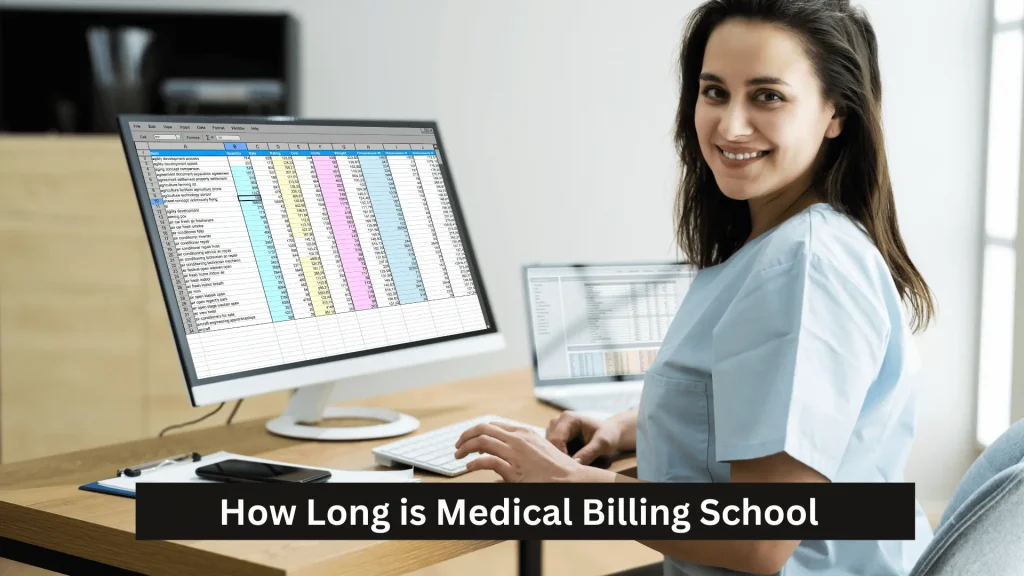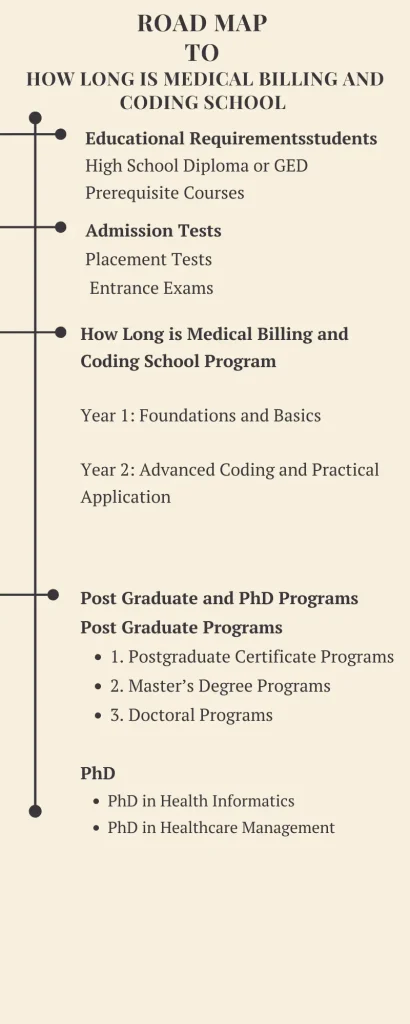Medical billing and coding school typically lasts between 9 months to 2 years, depending on the program and whether you pursue a certificate or associate degree. Certificate programs are shorter, often completed in under a year, while associate degrees take about two years. Understanding “How Long is Medical Billing and Coding School” helps in planning your education.
What is Medical Billing and Coding School
Medical billing and coding school provides specialized training to prepare students for careers in healthcare administration. The curriculum covers medical terminology, insurance procedures, coding systems, and billing processes. Students learn to accurately process medical claims, ensuring healthcare providers receive proper reimbursement.

Attending a medical billing and coding school can lead to certifications such as Certified Professional Coder (CPC) or Certified Billing and Coding Specialist (CBCS). These credentials enhance job prospects and earning potential in the healthcare industry. Graduates can work in hospitals, clinics, insurance companies, and other healthcare facilities.
How Long is Medical Billing and Coding School
Year 1: Foundations and Basics
Introduction to Medical Billing and Coding: Students learn the basics of medical billing and coding, including understanding the healthcare system and the role of billing and coding professionals.
Medical Terminology: A comprehensive study of medical terminology, anatomy, and physiology to understand the language used in healthcare documentation.
Basic Coding Systems: Introduction to coding systems such as ICD-10, CPT, and HCPCS, focusing on their structure and use.
Year 2: Advanced Coding and Practical Application
Advanced Coding Systems: In-depth study of ICD-10-CM, ICD-10-PCS, CPT, and HCPCS Level II codes, including guidelines for accurate coding.
Medical Billing Procedures: Detailed instruction on billing processes, insurance claims, reimbursement methodologies, and compliance with healthcare laws and regulations.
Practicum/Externship: Hands-on experience in a real-world healthcare setting, allowing students to apply their knowledge in medical billing and coding, interacting with electronic health records, and managing actual billing processes.
Certification Preparation: Preparation for certification exams such as the Certified Professional Coder (CPC) or Certified Billing and Coding Specialist (CBCS) to enhance employability.

HOW TO ENTER Medical Billing and Coding SCHOOL
Educational Requirements
High School Diploma or GED: Most programs require applicants to have a high school diploma or equivalent.
Basic Computer Skills: Proficiency in using computers, as coursework often involves electronic health records and billing software.
Prerequisite Courses: Some programs may require completion of basic courses in biology, anatomy, and medical terminology.
Entry Tests
Placement Tests: Schools may require placement tests to assess the applicant’s proficiency in math and English.
Entrance Exams: Some institutions might have specific entrance exams focusing on medical terminology and basic coding knowledge.
Application Process
Online Application: Complete an online application form available on the school’s website.
Transcripts: Submit official transcripts from high school or previous educational institutions.
Personal Statement: Write a personal statement or essay explaining your interest in medical billing and coding.
Letters of Recommendation: Provide letters of recommendation from teachers, employers, or professionals who can vouch for your capabilities.
Application Fee: Pay any required application fees.
Financial Aids
Federal Financial Aid: Apply for federal financial aid through the Free Application for Federal Student Aid (FAFSA).
Scholarships: Research and apply for scholarships specific to medical billing and coding or general healthcare fields.
Grants: Look for federal and state grants that do not require repayment.
Work-Study Programs: Consider work-study programs that offer part-time employment while attending school.
Student Loans: Explore federal and private student loan options to cover tuition and other expenses.
Ensuring you meet the educational requirements and understanding the application process will help in successfully gaining admission to a medical billing and coding program. Additionally, exploring financial aid options can make education more affordable.
Postgraduate and PhD Programs for Medical Billing and Coding School
While traditional postgraduate and PhD programs specifically in medical billing and coding are rare, there are advanced educational opportunities and related degrees that can enhance expertise in the field. Here’s a detailed overview of potential pathways for further education beyond a standard undergraduate degree:
1. Postgraduate Certificate Programs
Advanced Coding and Billing: Programs focusing on advanced coding techniques, management of complex billing scenarios, and new coding system updates.
Typical Duration: 6 months to 1 year.
Key Courses: Advanced ICD-10-CM/PCS Coding, Advanced CPT Coding, Compliance and Auditing.
Career Outcomes: Higher-level positions in healthcare management, specialized coding roles, or consulting.
Healthcare Administration: Certificates in healthcare administration offer advanced knowledge in managing healthcare facilities and departments.
Typical Duration: 6 months to 1 year.
Key Courses: Healthcare Management, Financial Management in Healthcare, Healthcare Law and Ethics.
Career Outcomes: Healthcare administrator, department manager, or executive roles in healthcare organizations.
2. Master’s Degree Programs
Master of Health Administration (MHA): Focuses on advanced management skills and strategic planning in healthcare settings.
Typical Duration: 2 years.
Key Courses: Health Policy, Strategic Management, Healthcare Operations.
Career Outcomes: Health services manager, director of operations, or executive roles in healthcare organizations.
Master of Science in Health Informatics (MSHI): Emphasizes the use of technology and data in healthcare.
Typical Duration: 2 years.
Key Courses: Health Information Systems, Data Analytics, Health Information Management.
Career Outcomes: Health informatics specialist, data analyst, or IT consultant in healthcare settings.
Master of Science in Health Information Management (MS-HIM): Focuses on the management of health information systems and data.
Typical Duration: 2 years.
Key Courses: Health Data Analysis, Health Information Systems, Healthcare Legal Issues.
Career Outcomes: Health information manager, compliance officer, or IT manager.
3. Doctoral Programs
Doctor of Health Administration (DHA): Advanced study in health administration focusing on leadership, policy, and strategy.
Typical Duration: 3 to 5 years.
Key Courses: Health Policy Development, Advanced Strategic Management, Leadership in Healthcare.
Career Outcomes: Senior executive roles, healthcare consultant, or academic positions in healthcare administration.
PhD in Health Informatics: A research-focused program exploring advanced topics in health information systems and technology.
Typical Duration: 3 to 5 years.
Key Courses: Research Methods in Health Informatics, Advanced Health Data Analytics, Health Information Policy.
Career Outcomes: Researcher, university professor, or policy advisor in health informatics.
PhD in Healthcare Management: Emphasizes advanced research in healthcare management practices and policies.
Typical Duration: 3 to 5 years.
Key Courses: Advanced Healthcare Management Theories, Research Methodologies, Healthcare Policy Analysis.
Career Outcomes: Academic researcher, consultant, or high-level executive roles.
4. Professional Development and Continuing Education
Workshops and Seminars: Short-term programs for ongoing education in new technologies, regulations, or advanced coding techniques.
Typical Duration: A few days to a few weeks.
Key Topics: Updates in Coding Guidelines, Healthcare Compliance Training, Emerging Technologies in Healthcare.
Career Outcomes: Continued professional development, certification maintenance, or skill enhancement.
5. Certifications and Fellowships
Fellowship Programs: Advanced training for experienced professionals in areas like healthcare compliance or medical auditing.
Typical Duration: Varies.
Key Examples: Certified Professional Medical Auditor (CPMA), Certified in Healthcare Compliance (CHC).
Career Outcomes: Specialized roles in auditing, compliance, or consultancy.
Top 10 Medical Billing and Coding Schools
Here are ten of the best schools for medical billing and coding programs based on various factors such as program quality, accreditation, faculty credentials, and student reviews:

1. Pima Medical Institute
Programs Offered: Medical Billing and Coding Certificate, Associate Degree in Medical Billing and Coding
Highlights: Pima Medical Institute offers comprehensive programs with hands-on training, experienced instructors, and job placement assistance.
Location: Multiple locations nationwide and online options.
2. Southern Careers Institute
Programs Offered: Medical Billing and Coding Specialist Certificate
Highlights: Focuses on practical skills, with a curriculum designed to prepare students for certification exams and entry-level positions.
Location: Multiple campuses in Texas and online.
3. Ashworth College
Programs Offered: Medical Billing and Coding Certification, Associate Degree in Medical Billing and Coding
Highlights: Offers flexible online programs with a self-paced learning environment and career services.
Location: Online.
4. Penn Foster College
Programs Offered: Medical Billing and Coding Certificate, Associate Degree in Medical Billing and Coding
Highlights: Provides affordable online programs with 24/7 access to course materials and personalized support.
Location: Online.
5. Herzing University
Programs Offered: Medical Billing and Coding Specialist Diploma, Associate Degree in Medical Billing and Coding
Highlights: Offers both in-person and online classes with a focus on real-world skills and industry certifications.
Location: Multiple campuses and online.
6. Capella University
Programs Offered: Medical Coding Certificate, Bachelor’s Degree in Health Care Administration with a focus on Medical Coding
Highlights: Features accredited programs with a strong emphasis on advanced coding practices and career readiness.
Location: Online.
7. American Health Information Management Association (AHIMA)
Programs Offered: Certified Coding Associate (CCA) Exam Preparation
Highlights: AHIMA provides certification preparation resources and continuing education for medical billing and coding professionals.
Location: Online.
8. AAPC (American Academy of Professional Coders)
Programs Offered: CPC Certification Training, CPC Exam Preparation
Highlights: AAPC offers industry-recognized certification preparation and extensive resources for career advancement.
Location: Online and in-person workshops.
9. Keiser University
Programs Offered: Medical Billing and Coding Diploma, Associate Degree in Medical Billing and Coding
Highlights: Offers hands-on training, experienced faculty, and strong job placement support.
Location: Multiple campuses and online.
10. Walden University
Programs Offered: Bachelor’s Degree in Health Informatics with Medical Coding Focus
Highlights: Offers advanced education with a focus on health informatics and medical coding, preparing students for leadership roles.
Location: Online.
Factors Affecting the Length of Medical Billing and Coding School
Several factors can influence how long it takes to complete a medical billing and coding program. Here are the main factors with detailed explanations:
1. Program Type
Certificate Programs
Duration: 6 months to 1 year.
Description: These are shorter, focused programs designed for quick entry into the field. They cover essential skills for entry-level positions.
Diploma Programs
Duration: 1 to 2 years.
Description: Diplomas provide a more comprehensive education than certificates and often include practical experience.
Associate Degree Programs
Duration: 2 years.
Description: These programs offer a more in-depth education with broader coverage of medical billing and coding along with general education courses.
2. Full-Time vs. Part-Time Enrollment
Full-Time Enrollment
Duration: Shorter program duration due to the concentrated schedule.
Description: Students complete more credits per term, which accelerates their progress through the program.
Part-Time Enrollment
Duration: Longer program duration due to fewer credits per term.
Description: Allows for a more flexible schedule but extends the time needed to complete the program.
3. Online vs. On-Campus Programs
Online Programs
Duration: Flexible but can be completed in the same time frame as on-campus programs.
Description: Offers flexibility for students who work or have other commitments, though it may require self-discipline to stay on track.
On-Campus Programs
Duration: Typically follows a fixed schedule.
Description: Provides structured learning environments with direct access to instructors and resources.
4. Prerequisites and Placement Tests
Prerequisite Courses
Duration: Additional time if students need to complete prerequisites.
Description: Some programs require completion of basic courses before enrolling in advanced classes.
Placement Tests
Duration: Short term but may affect the start date.
Description: Tests to assess the student’s readiness for the program, potentially affecting the course schedule.
5. Externships or Practicums
Externship Requirements
Duration: Adds time to the program.
Description: Some programs require externships or practical experience in a real-world setting, which extends the program’s length.
Program Integration
Duration: Can be integrated into the program or require additional time.
Description: Externships can be part of the curriculum or a separate requirement.
Final Verdict
Medical billing and coding is a dynamic field with various educational paths. From certificate programs to advanced degrees, choosing the right path depends on your career goals and timeline. With diverse options, you can find a program that fits your schedule and helps you succeed in this rewarding profession.
FAQs
1. What is the duration of a medical billing and coding school program?
Most programs last from 6 months to 2 years, depending on the type of program and your enrollment status.
2. What educational requirements are needed for medical billing and coding school?
A high school diploma or GED is required, and some programs may require basic computer skills or prerequisite courses.
3. Are there any entry tests for medical billing and coding programs?
Some schools require placement tests for math and English, while others might have specific entrance exams for medical terminology and coding.
4. What financial aid options are available for medical billing and coding students?
Students can apply for federal financial aid, scholarships, grants, work-study programs, and student loans to help cover tuition and expenses.
5. What are the career prospects after completing a medical billing and coding program?
Graduates can pursue careers as medical billers, coders, health information technicians, or take advanced roles in healthcare administration and compliance.
